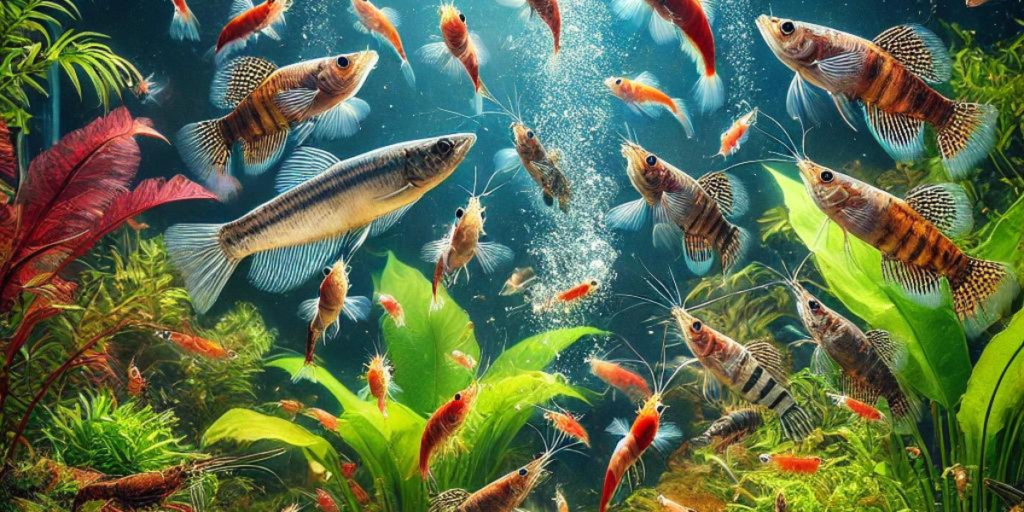Welcome, aquatic enthusiasts! If you’re looking to elevate your aquarium game and give your fish a delicious boost of nutrition, you’ve come to the right place. Enter feeder shrimp—the tiny titans of the tank world! These little critters may be small in size, but they pack a powerful punch when it comes to enriching your fish’s diet and stimulating their natural hunting instincts. In this essential guide, we’ll dive into everything you need to know about incorporating feeder shrimp into your aquatic ecosystem—from understanding their nutritional benefits and optimal care tips to selecting the best varieties for your finned friends. So grab your nets and prepare for an underwater adventure that promises both health and happiness for your beloved fish!
Introduction to Feeder Shrimp and Their Role in the Aquatic Ecosystem
Feeder shrimp may be small, but they pack a powerful punch in the world of aquarium care. These tiny creatures serve as an essential food source for many fish species, bringing not just nourishment but also excitement and enrichment to your underwater environment. Whether you’re a seasoned aquarist or just starting out, understanding the role of feeder shrimp can transform your tank into a thriving aquatic ecosystem.
Imagine watching your fish darting about with energy, their colors vibrant and lively. That’s the magic that good nutrition can bring! Feeder shrimp contribute not only to the diet of your finned friends but also help maintain a balanced habitat within your aquarium. Let’s dive deeper into what makes these little critters so important for both fish health and overall tank happiness.
Types of Feeder Shrimp: A Comparison of Ghost, Cherry, and Amano Shrimp
When it comes to feeder shrimp, three popular types stand out: Ghost, Cherry, and Amano shrimp. Each offers unique characteristics that can enhance your aquarium.
Ghost shrimp are transparent and great for observing their behavior. Their natural camouflage makes them a fascinating addition to any tank. They thrive in various environments and help keep the substrate clean by scavenging leftover food.
Cherry shrimp are vibrant with striking red colors that brighten up any setup. Not only do they provide visual appeal, but they also reproduce easily in captivity, creating a sustainable source of live prey for larger fish species.
Amano shrimp are known for their impressive algae-eating capabilities. These hardworking creatures contribute significantly to maintaining water quality while serving as nutritious snacks for hungry fish.
Choosing the right type depends on your aquarium’s needs and the specific dietary requirements of your fish population.
Benefits of Adding Feeder Shrimp to Your Aquarium
Feeder shrimp are more than just a food source; they add life and movement to your aquarium. Their natural behavior provides visual interest, making the tank feel vibrant and dynamic.
These small creatures also contribute to the ecosystem by helping maintain water quality. As they scavenge for algae and leftover food, feeder shrimp play an essential role in keeping your aquarium clean.
Additionally, many fish species thrive on a varied diet that includes live prey. By introducing feeder shrimp, you can enhance their nutrition while stimulating their hunting instincts. This not only promotes healthier growth but also encourages natural behaviors.
Moreover, watching fish interact with live feeders can be incredibly rewarding for aquarists. It creates an engaging experience that connects you with the underwater world in a unique way.
How to Choose Healthy Feeder Shrimp for Your Fish
Selecting healthy feeder shrimp is crucial for your aquarium’s ecosystem. Start by checking the color and clarity of the shrimp. Vibrant colors usually indicate good health, while dull or faded appearances can be a red flag.
Next, observe their movement. Active and agile shrimp are typically healthier than those that seem sluggish or lethargic. Pay attention to any signs of distress, such as floating at the surface or hiding excessively.
Examine their environment in the store too. A clean tank with proper filtration and temperature reflects better care practices from suppliers. This often translates to healthier stock.
Lastly, avoid purchasing large quantities at once. Opt for smaller batches so you can monitor their well-being before introducing them into your main tank setup. Healthy feeder shrimp contribute positively to your fish’s diet and overall vitality in an aquarium setting.
Proper Care and Feeding for Feeder Shrimp
Feeder shrimp require a balanced diet to thrive. A mix of high-quality algae and specially formulated shrimp food keeps them healthy. They also enjoy blanched vegetables like zucchini or spinach.
Maintaining clean water is crucial for their well-being. Regularly check parameters such as pH, ammonia, and nitrate levels. Using a sponge filter can help keep the environment stable without sucking up your tiny swimmers.
Temperature matters too; most feeder shrimp prefer a range between 72°F to 78°F (22°C to 26°C). Sudden changes can stress them out, so gradual adjustments are key.
Provide hiding spots with plants or decorations. This not only makes them feel secure but also encourages natural behavior and reduces stress from tank mates.
Finally, feed small amounts daily rather than overfeeding. Monitoring how much they consume helps prevent waste buildup in the aquarium, ensuring a healthier habitat overall.
Alternative Uses for Feeder Shrimp in Your Aquarium
Feeder shrimp can serve more purposes than just being a tasty treat for your fish. These tiny creatures can help maintain the health of your aquarium in several ways.
One notable use is as scavengers. Feeder shrimp will forage around the tank, picking up uneaten food and detritus. This behavior helps keep the substrate clean and reduces waste buildup.
Additionally, they play an essential role in fostering a balanced ecosystem. As they grow and reproduce, they contribute to the biodiversity within your tank. This diversity creates a healthier environment for all aquatic inhabitants.
Some aquarists even use feeder shrimp as live plants fertilization by introducing them to tanks with young vegetation. Their waste provides nutrients that encourage plant growth, creating lush greenery alongside vibrant fish life.
These versatile little creatures truly add value beyond their initial purpose as prey.
Common Mistakes to Avoid When Using Feeder Shrimp as Prey for Your Fish
Using feeder shrimp can be a rewarding experience, but there are some common pitfalls to avoid. One mistake is assuming all fish will readily accept them as food. Some species may need time to adjust or might prefer other types of feed initially.
Another frequent error is neglecting the water quality in your aquarium. Introducing live prey can lead to spikes in ammonia and nitrites if not managed properly. Regular monitoring and maintenance are crucial.
Don’t overlook the importance of size when selecting feeder shrimp. Offering too large a meal can stress smaller fish, while too small could go unnoticed by larger tank inhabitants.
Lastly, failing to quarantine new feeder shrimp before introducing them into your main tank can introduce diseases and parasites. A little patience goes a long way toward maintaining a healthy aquatic environment for both feeders and residents alike.
Conclusion: Why Feeder Shrimp are a Valuable Addition to Any Aquarium Setup
Feeder shrimp bring a host of benefits to any aquarium setup. They serve as a natural food source for various fish species, enhancing their diet and promoting healthier growth. These small creatures also contribute to the ecosystem by helping maintain water quality through their scavenging habits.
Incorporating feeder shrimp into your tank can create an engaging environment for both fish and aquarists alike. Watching predatory behaviors in action offers entertainment and education, bridging the gap between nature and home aquariums. Their vibrant colors add aesthetic value too, especially with varieties like cherry shrimp.
When selected carefully and provided proper care, feeder shrimp thrive alongside your fish while enriching the overall aquatic experience. They’re not just prey; they play multiple roles within the community tank setting.
Adding feeder shrimp is more than just about feeding your fish—it’s about creating a balanced ecosystem that keeps all inhabitants happy and healthy. Embracing these tiny yet mighty creatures can elevate your aquarium game significantly.






